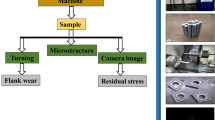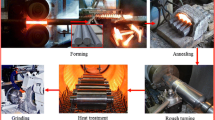Abstract
Hard turning technology was proven effective in enhancing the surface finish and dimensional accuracy of hardened steel. For this reason, it is used for finishing operations in the manufacturing of some critical aircraft landing gear components where bulk material hardness exceeds 45 HRC such as 300M ultra-high-strength steel. Nonetheless, the selection of cutting conditions remains critical to ensure generated surface characteristics meet the performance requirements. In this context, this study focuses on the optimization of hard turning cutting conditions to reduce surface roughness, increase compressive surface residual stresses, and reduce surface white layer thickness of 300M ultra-high-strength steel (55 HRC). To this end, a design of experiments (DoE) is used to investigate the effects of cutting tool (T), cutting speed (V), feed rate (f), and depth of cut (D) during hard turning. The cutting tool materials investigated include physical vapor deposited AlTiN–coated cemented carbide, mixed ceramic, and polycrystalline cubic boron nitride (PCBN), all commonly used in hard turning. Three different optimization approaches are evaluated and compared, namely the single-response Taguchi method, the multi-response grey relational analysis (GRA), and the proportion quality loss reduction (PQLR) methodologies. Because responses were found to be correlated, the selected multi-response optimization approaches were combined with the principal component analysis (PCA) method to transform correlated parameters into uncorrelated ones. The effect of cutting parameters and their interactions on surface roughness (Ra) and white layer thickness (WL) were considered in detail, particularly the effect of cutting tool material. Results demonstrate that the PCA-based GRA approach is a very suitable optimization technique for hard turning of 300M steel. Under those optimized conditions, Ra was decreased by 50%, and WL was decreased by 6% while compressive axial surface residual stress (ASRS) and hoop surface residual stress (HSRS) were increased by 307% and 74%, respectively.









Similar content being viewed by others
References
Matsumoto Y, Hashimoto F, Lahoti G (1999) Surface integrity generated by precision hard turning. CIRP Ann Manuf Technol 48(1):59–62
Rech J, Moisan A (2003) Surface integrity in finish hard turning of case-hardened steels. Int J Mach Tools Manuf 43(5):543–550
Tonshoff HK, Arendt C, Ben Amor R (2000) Cutting of hardened steel. CIRP Ann Manuf Technol 49(2):547–566
Zhang X, Liu CR, Yao Z (2007) Experimental study and evaluation methodology on hard surface integrity. Int J Adv Manuf Technol 34(1–2):141–148
Javidi A, Rieger U, Eichlseder W (2008) The effect of machining on the surface integrity and fatigue life. Int J Fatigue 30(10–11):2050–2055
Akcan S, Shah WIS, Moylan SP, Chandrasekar S, Chhabra PN, Yang HTY (2002) Formation of white layers in steels by machining and their characteristics. Metall Mater Trans A 33(4):1245–1254
Capello E, Davoli P, Filippini M, Foletti S (2004) Relaxation of residual stresses induced by turning and shot peening on steels. J Strain Anal Eng Des 39(3):285–290
Chinchanikar S, Choudhury SK (2013) Effect of work material hardness and cutting parameters on performance of coated carbide tool when turning hardened steel: an optimization approach. Measurement 46(4):1572–1584
Chinchanikar S, Choudhury SK (2013) Investigations on machinability aspects of hardened AISI 4340 steel at different levels of hardness using coated carbide tools. Int J Refract Met Hard Mater 38:124–133
Coto B, Navas VG, Gonzalo O, Aranzabe A, Sanz C (2011) Influences of turning parameters in surface residual stresses in AISI 4340 steel. Int J Adv Manuf Technol 53(9–12):911–919
Çydaş U (2010) Machinability evaluation in hard turning of AISI 4340 steel with different cutting tools using statistical techniques. Proc Inst Mech Eng B J Eng Manuf 224(7):1043–1055
Lima JG, Ávila RF, Abrão AM, Faustino M, Davim JP (2005) Hard turning: AISI 4340 high strength low alloy steel and AISI D2 cold work tool steel. J Mater Process Technol 169(3):388–395
Navas VG, Gonzalo O, Bengoetxea I (2012) Effect of cutting parameters in the surface residual stresses generated by turning in AISI 4340 steel. Int J Mach Tools Manuf 61:48–57
Sahu S, Choudhury BB (2015) Optimization of surface roughness using Taguchi methodology & prediction of tool wear in hard turning tools. Materials Today 2(4):2615–2623
Suresh R, Basavarajappa S, Gaitonde VN, Samuel GL (2012) Machinability investigations on hardened AISI 4340 steel using coated carbide insert. Int J Refract Met Hard Mater 33:75–86
Huiping Z, Hongxia Z, Yinan L (2014) Surface roughness and residual stresses of high speed turning 300 M ultrahigh strength steel. AIME 2014
Varela PI, Rakurty CS, Balaji AK (2014) Surface integrity in hard machining of 300M steel: effect of cutting-edge geometry on machining induced residual stresses. Procedia CIRP 13:288–293
Jomaa W, Songmene V, Bocher P (2016) An investigation of machining-induced residual stresses and microstructure of induction-hardened AISI 4340 steel. Mater Manuf Process 31(7):838–844
Agrawal A, Goel S, Rashid WB, Price M (2015) Prediction of surface roughness during hard turning of AISI 4340 steel (69 HRC). Appl Soft Comput 30:279–286
Mandal N, Doloi B, Mondal B (2013) Predictive modeling of surface roughness in high speed machining of AISI 4340 steel using yttria stabilized zirconia toughened alumina turning insert. Int J Refract Met Hard Mater 38:40–46
Rashid WB, Goel S, Davim JP, Joshi SN (2016) Parametric design optimization of hard turning of AISI 4340 steel (69 HRC). Int J Adv Manuf Technol 82(1–4):451–462
Sohrabpoor H, Khanghah SP, Teimouri R (2014) Investigation of lubricant condition and machining parameters while turning of AISI 4340. Int J Adv Manuf Technol 76(9–12):2099–2116
Tzeng C-J, Lin YH, Yang YK, Jeng MC (2009) Optimization of turning operations with multiple performance characteristics using the Taguchi method and grey relational analysis. J Mater Process Technol 209(6):2753–2759
Datta S et al (2009) Application of PCA-based hybrid Taguchi method for correlated multicriteria optimization of submerged arc weld: a case study. Int J Adv Manuf Technol 45(3):276
Wu F-C, Chyu C-C (2004) Optimization of correlated multiple quality characteristics robust design using principal component analysis. J Manuf Syst 23(2):134–143
Nalbant M, Gökkaya H, Sur G (2007) Application of Taguchi method in the optimization of cutting parameters for surface roughness in turning. Mater Des 28(4):1379–1385
Kuo Y, Yang T, Huang G-W (2008) The use of a grey-based Taguchi method for optimizing multi-response simulation problems. Eng Optim 40(6):517–528
Lu HS, Chang CK, Hwang NC, Chung CT (2009) Grey relational analysis coupled with principal component analysis for optimization design of the cutting parameters in high-speed end milling. J Mater Process Technol 209(8):3808–3817
Fung CP, Kang PC (2005) Multi-response optimization in friction properties of PBT composites using Taguchi method and principle component analysis. J Mater Process Technol 170(3):602–610
Huang JT, Liao YS (2003) Optimization of machining parameters of wire-EDM based on grey relational and statistical analyses. Int J Prod Res 41(8):1707–1720
Grzesik W, Wanat T (2006) Surface finish generated in hard turning of quenched alloy steel parts using conventional and wiper ceramic inserts. Int J Mach Tools Manuf 46(15):1988–1995
Poulachon G, Bandyopadhyay BP, Jawahir IS, Pheulpin S, Seguin E (2003) The influence of the microstructure of hardened tool steel workpiece on the wear of PCBN cutting tools. Int J Mach Tools Manuf 43(2):139–144
Griffiths B (2001) 4—Surface finish characterization. In: Griffiths B (ed) Manufacturing surface technology. Kogan Page Science, Oxford, pp 109–151
Funding
This work was supported by the Consortium for Research and Innovation in Aerospace in Quebec (CRIAQ), MITACS, the Natural Sciences and Engineering Research Council (NSERC), Héroux-Devtek, and Pratt & Whitney Canada.
Author information
Authors and Affiliations
Corresponding author
Additional information
Publisher’s note
Springer Nature remains neutral with regard to jurisdictional claims in published maps and institutional affiliations.
Rights and permissions
About this article
Cite this article
Ajaja, J., Jomaa, W., Bocher, P. et al. Hard turning multi-performance optimization for improving the surface integrity of 300M ultra-high strength steel. Int J Adv Manuf Technol 104, 141–157 (2019). https://doi.org/10.1007/s00170-019-03863-3
Received:
Accepted:
Published:
Issue Date:
DOI: https://doi.org/10.1007/s00170-019-03863-3




